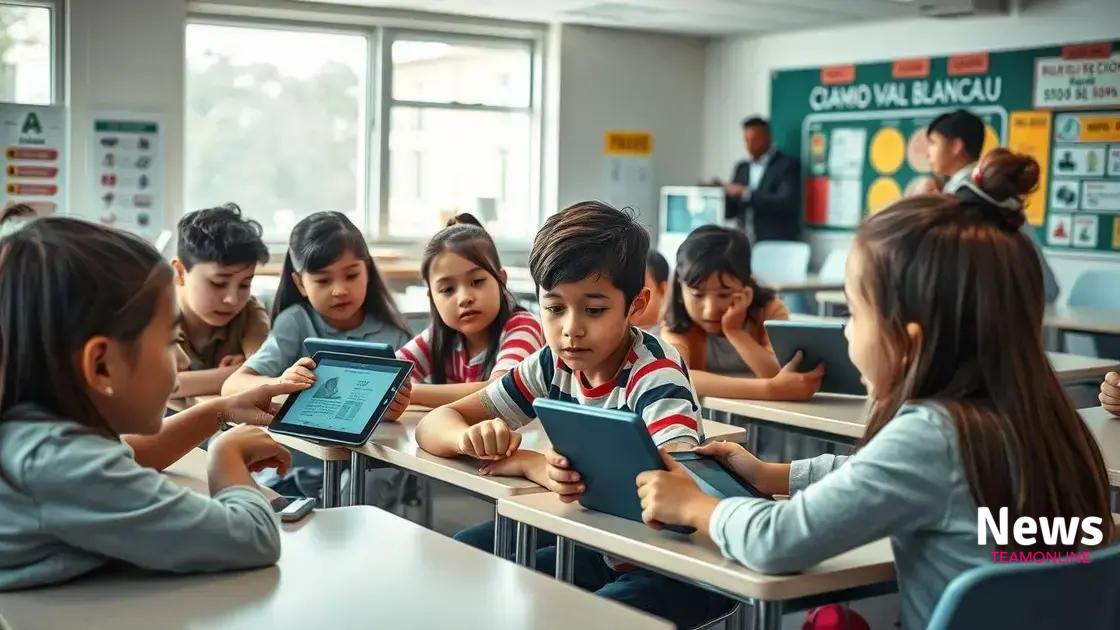Bilingual learning platform regulations: what you need to know

Bilingual learning platform regulations are essential for ensuring quality education, addressing diverse student needs, promoting safety, and enhancing learning outcomes through compliance with established standards.
Bilingual learning platform regulations are vital for ensuring quality and effectiveness in education. Have you considered how these rules can shape a better learning environment? This article dives into what you need to know.
Understanding bilingual learning platform regulations
Understanding bilingual learning platform regulations is crucial for educators and developers involved in this vital field. These regulations help ensure that platforms meet essential standards to provide effective learning experiences.
Importance of Compliance
Compliance with regulations allows platforms to address various educational needs. Educators must recognize the significance of these laws in promoting accessibility and quality.
- Ensures equitable access to learners
- Improves educational outcomes
- Fosters a safe learning environment
Understanding these regulations can seem complex. However, breaking them down into key components can make it easier. They often include language proficiency standards, curriculum requirements, and assessments.
Key Components of Regulations
Each component plays a critical role in shaping the platform’s effectiveness. Language proficiency standards ensure that students can engage with learning materials appropriately.
- Curriculum requirements guide the content used in bilingual education
- Assessment standards measure student progress
- Accountability measures track compliance
Furthermore, keeping abreast of changes in regulations is essential. Education laws may evolve, affecting how platforms operate. Regular updates ensure platforms remain compliant and responsive to learners’ needs.
In conclusion, navigating bilingual learning platform regulations benefits both educators and students. By understanding these guidelines, stakeholders can enhance the overall learning experience.
Key requirements for compliance
Key requirements for compliance in bilingual learning platforms are essential to ensure quality and effective education. These requirements often vary by region and depend on the specific goals of the educational program.
Essential Standards
Understanding what is needed for compliance is critical. Many regulations demand adherence to specific standards that help ensure students receive appropriate educational support.
- Language proficiency benchmarks to assess student capabilities
- Culturally relevant curricula that meet diverse needs
- Accessibility standards for all learners
Each of these standards plays a crucial role. They help maintain a level of quality that benefits all students in a bilingual environment. Furthermore, organizations must also focus on proper training for educators to meet these requirements effectively.
Monitoring and Evaluation
Effective monitoring ensures that platforms remain compliant with established requirements. Regular evaluations help identify areas that need improvement. Compliance shouldn’t only be about meeting the standards at a point in time but also about continually enhancing educational practices.
- Conducting regular assessments of language skills
- Feedback mechanisms for students and parents
- Data collection to inform necessary adjustments
In addition, transparent communication about compliance practices can foster trust among stakeholders. Building a culture of accountability encourages cooperation among educators, students, and parents.
Establishing these key requirements for compliance forms the backbone of successful bilingual learning platforms. Aiming for excellence in these areas leads to significantly better educational outcomes for all involved.
Challenges faced by bilingual learning platforms

Bilingual learning platforms encounter several challenges that can impact their effectiveness. These challenges are crucial to identify as they shape the overall educational experience for students.
Understanding Diverse Needs
One of the major hurdles is understanding the diverse needs of learners. Each student comes with a unique background, which affects how they interact with bilingual material. Addressing this diversity requires tailored approaches that meet different learning styles.
- Varying levels of language proficiency
- Cultural differences influencing engagement
- Diverse academic backgrounds
Meeting these varied needs is essential in creating an inclusive environment. Educators must assess and adapt their methods regularly, ensuring that no student is left behind.
Technological Barriers
Another significant challenge is the reliance on technology. While many platforms depend on tech to deliver bilingual content, not all students have equal access to devices or the internet. This digital divide can hinder some learners from fully participating and benefiting from the platform.
- Inconsistent internet access across regions
- Lack of suitable devices among students
- Difficulty in training educators on new technologies
Additionally, keeping the technology up-to-date poses its own set of problems. Platforms must continually invest in their systems to ensure they remain user-friendly and effective.
A further complication in bilingual platforms involves regulatory compliance. Navigating the rules regarding educational standards can be daunting. It often requires significant resources to stay updated and comply with all local and national regulations.
Recognizing and addressing these challenges faced by bilingual learning platforms is crucial to enhance their effectiveness and ensure all students achieve their educational goals.
Benefits of following regulations
Following regulations in bilingual learning platforms offers numerous benefits that enhance the quality of education. These regulations help create a structured environment for both educators and students.
Enhanced Learning Outcomes
When platforms comply with established guidelines, they often see improved learning outcomes. This is primarily due to the focus on ensuring that all students receive quality content that meets their needs.
- Standardized assessments to measure student progress
- Curricula that supports diverse learning styles
- Increased engagement through interactive materials
These factors contribute to a more effective educational experience, encouraging students to excel in their language acquisition.
Increased Student Safety
Regulations also play a critical role in ensuring student safety. By adhering to safety guidelines, platforms help create an environment where learners can focus on their education without unnecessary risks.
- Protecting sensitive student information
- Ensuring safe interactions between students
- Providing resources for reporting concerns
When safety is prioritized, it fosters a supportive community that encourages open communication. Students are more likely to thrive when they feel secure in their learning environment.
Another significant benefit is the reputation boost for educational institutions. By complying with regulations, platforms can demonstrate their commitment to educational excellence and accountability. This can attract more students and partnerships, creating a positive feedback loop.
Institutions that prioritize compliance also tend to receive better funding opportunities. Many grant programs and sponsorships favor organizations that meet regulatory standards, helping them expand their offerings.
Ultimately, the benefits of following regulations extend beyond mere compliance. These advantages contribute to a rich, supportive educational experience that empowers both students and educators.
Future trends in bilingual education
Future trends in bilingual education are shaping how students learn languages worldwide. As the demand for bilingual skills continues to grow, educational platforms are adapting to meet new challenges and opportunities.
Integration of Technology
Technology is a significant driving force behind these changes. Advanced tools, such as artificial intelligence and machine learning, are beginning to play a crucial role in personalized education. This integration allows for tailored learning experiences that cater to individual student needs.
- Adaptive learning platforms that adjust content based on student progress
- Virtual and augmented reality to enhance language immersion experiences
- Online resources that provide instant feedback and support
These innovations help make learning more engaging and effective, giving students the chance to practice language skills in real-world contexts.
Focus on Cultural Competence
Another emerging trend is the increased emphasis on cultural competence. Understanding the cultural context of a language is essential for effective communication and social interaction. Educators are now incorporating cultural elements into their curricula.
- Exploring cultural habits, traditions, and histories through a bilingual lens
- Encouraging students to connect with native speakers
- Using authentic materials, like songs and films, to enrich learning
By focusing on cultural aspects, students gain a deeper appreciation for the language they’re learning. This approach not only enhances language skills but also fosters empathy and global awareness.
Furthermore, as educational policies evolve, there is a growing movement toward inclusion and equity. Advocates are calling for more supportive environments that address the unique needs of bilingual students, ensuring that every learner can thrive.
Schools are increasingly adopting dual-language programs that promote proficiency in both languages while also valuing the use of the student’s home language. These programs are showing positive outcomes in academic achievement and social development.
Overall, the future trends in bilingual education point toward a dynamic and inclusive approach that values technology, cultural competence, and equity in learning. These trends will surely help shape the next generation of bilingual learners, preparing them for success in a global society.
In conclusion, bilingual education is crucial for developing language skills in today’s global society. By understanding the challenges and embracing future trends, educators can create dynamic learning environments. These trends highlight the importance of technology, cultural competence, and compliance with regulations. As we move forward, focusing on these areas will help cultivate a new generation of bilingual learners, preparing them for success in a diverse world.
FAQ – Frequently Asked Questions about Bilingual Education
What are the benefits of bilingual education?
Bilingual education offers improved language skills, cultural awareness, and greater job opportunities in a globalized world.
How does technology enhance bilingual learning?
Technology provides interactive tools, personalized learning experiences, and instant feedback, making language acquisition more engaging.
What challenges do bilingual learning platforms face?
Challenges include addressing diverse student needs, ensuring access to technology, and complying with educational regulations.
Why is cultural competence important in bilingual education?
Cultural competence helps students understand and appreciate different perspectives, leading to more effective communication and collaboration.





